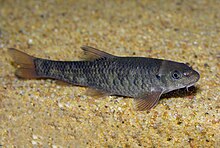| Garra | |
|---|---|

| |
| Doctor fish (Garra rufa) | |
| Scientific classification | |
| Domain: | Eukaryota |
| Kingdom: | Animalia |
| Phylum: | Chordata |
| Class: | Actinopterygii |
| Order: | Cypriniformes |
| Family: | Cyprinidae |
| Subfamily: | Labeoninae |
| Genus: | Garra F. Hamilton, 1822 |
| Type species | |
| Cyprinus (Garra) lamta F. Hamilton, 1822
| |
| Synonyms | |
|
Ageneiogarra Garman, 1912 | |
Garra is a genus of fish in the family Cyprinidae. These fish are one example of the "log suckers", sucker-mouthed barbs and other cyprinids commonly kept in aquaria to keep down algae. The doctor fish of Anatolia and the Middle East belongs in this genus.[1] The majority of the more than 160 species of garras are native to Asia, but about one-fifth of the species are from Africa (East, Middle and West, but by far the highest species richness in Ethiopia).[2][3]
The genus was established by Francis Buchanan-Hamilton in 1822 as a subgenus of Cyprinus (which at that time was a "basket genus" for carp-like cyprinids); though it didn't lead to an act of him to designate a type species by the time. However, as no other garras except the newly discovered G. lamta were known to science in 1822, this was designated as the type species by Pieter Bleeker in 1863. The garras and their closest relatives are sometimes placed in a subfamily Garrinae, but this seems hardly warranted. More often, this group is included in the Labeoninae, or together with these in the Cyprininae. In the former case, the garras are members of the labeonine tribe Garrini, in the latter they are in the subtribe Garraina of tribe Labeonini. The genus Discogobio is a close relative.[3]
- ^ Froese, Rainer; Pauly, Daniel (eds.). "Garra rufa". FishBase. August 2017 version.
- ^ Froese, Rainer; Pauly, Daniel (eds.). "Species in genus Garra". FishBase. March 2017 version.
- ^ a b Stiassny, M.L.J. & Getahun, A. (2007): An overview of labeonin relationships and the phylogenetic placement of the Afro-Asian genus Garra Hamilton, 1922 (Teleostei: Cyprinidae), with the description of five new species of Garra from Ethiopia, and a key to all African species. Archived 2008-12-02 at the Wayback Machine Zoological Journal of the Linnean Society, 150 (1): 41–83.